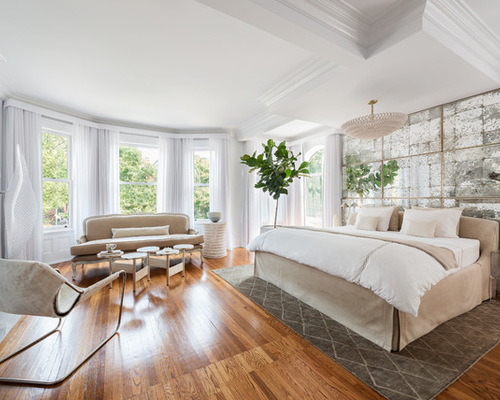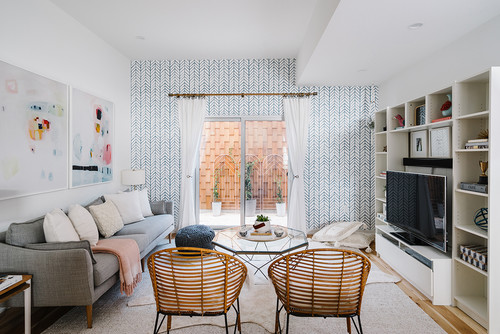Arm yourself with design tools to figure out and execute a fantastic focus in any room
The idea of “focal points” comes up often in decor discussions, but how do you define and decide on these seemingly all-important design details? In this guide, I’ll break down what exactly a focal point is, whether you need one and how to incorporate this concept into your real-world room.
There can be multiple ways to define a focal point. In photography or painting, it is literally the point at which the “eye” or lens capturing the image is focused.In interior design, a focal point is similar: It is an area that draws our attention due to being more dramatic than other areas. It can be one bold piece (such as a large-scale artwork) or a grouping of items (such as this painting placed just above the dark fireplace). Whatever it is, and for whatever reason (be it color, pattern or size), a focal point draws the eye more strongly than other areas of the room.
Keep in mind that a focal point does not have to be a wall or part of a wall. Bold carpets or floors, hanging lights and even furniture pieces can also be strong visual features that capture our focus.Here, the beautiful carpet grounding this seating area, along with the dark, chunky coffee table and the chandelier, create a focal point in the center of the space, drawing the eye into the room rather than only to the walls.
Can you identify the focal point in this room? Many people would say it is the fireplace and TV wall, around which the furniture is arranged. Others might say it is the vast, dramatic window wall with a great view to nature that’s “on” all day. Others still might pick the ceiling — epically high with bold accents and a commanding chandelier.Here’s what I would pick: all of the above. The idea that a room must have one singular focal point is a myth. Rooms are complex, with multiple features and functions, so it makes sense that we accept them having more than one focal point.
This idea of embracing multiple focal points can apply to any room, but it is especially true for rooms that are a little larger, with multiple functional areas. This luxurious bedroom has a spectacular headboard, but it also has interest in other places, such as the sofa wall with its dreamy windows, or the inviting fireplace.
Piling all the drama onto one wall can leave a space looking lopsided, but creating multiple focal points keeps the eye moving through the space and leaves it feeling more balanced.
In reality, there is no absolute limit to the number of focal points a room can have. However, if you’re less confident in your designer eye and want a helpful rule, sticking to a maximum of three focal points will help make sure the room stays orderly. In a smaller space, sticking to a maximum of two is the safest. It’s not an unbreakable rule, but it can make things easier.
All of this being said, when you do have multiple focal points, you should still consider making one the dominant focal point. This helps to provide a room with a sense of visual structure.Your eye has a strong spot to begin and end on as it explores the room, finding other focal points, and this conveys a sense of order in our minds. This logical sense of structure can help a space carry lots of interest without feeling so busy, so you achieve a lively look without it feeling unkempt.
Often, this is where using an “accent wall” comes in: using a dark shade, a bold hue or an eye-catching pattern on a wall to really make that focal point dominate over any others. In this case, the dark paint surrounding the fireplace makes it even more dramatic than the beautiful windows.
If the paint had been applied to the window wall instead, the windows probably would feel like the strongest feature, and the room could work that way too.
It’s not the only way to define a dominant focal point, but it is an effective one.
So how do you know where the focal points in your room should be?Luckily, the focal points are often easily determined by the room shape. Many rooms, despite technically having more than four walls, only actually have a few full walls that can become focal points. Once you eliminate the wall(s) with doorways or closets, many rooms only have one or two walls left open.Take this example, where the room is open from two sides. This leaves just the fireplace wall and a second wall to become a TV wall. The TV wall has more room to work with (and the furniture naturally faces it), so by default it becomes the easiest choice for a dominant focal point.
Focal points can also be determined by function in a room. If a small room has one sole function (such as watching TV or sleeping), it can have just one focal point. But when a room has multiple uses, it makes sense to give a focal point to each.
Here, the window is a major focal point when chatting or reading in the daytime, but the piano becomes more of a focus during, say, an evening singalong. Ultimately, the dark, glossy piano is hard to avoid as a dominant focal point, so the designer embraced that with equally vibrant yellow curtains.
If an area or piece cries out to be the star of the room, don’t fight it, support it.
Ultimately, when you’re picking the strongest focal point in a room, you may want to resort to the most straightforward option: the wall or area that you’re first facing when you step into the space.In this example, the TV wall is of course a focal point when you are planted on the sofa (to watch TV, most likely). But as you first approach, the accent wallpaper framing the sliding doors makes that wall the dominant focus and pulls you into the space.
It is often tempting to make windows the sole focal point in a room. After all, who wants to admit that they’d rather look at a TV than a beautiful nature scene?While windows make a great statement during the daylight hours, they often become less captivating during the evening (depending on the view). If your entire decor is oriented solely around a window, then what remains of your focal point when the sun goes down?Balancing a window with one or two other focal points (such as some great art or a room-expanding mirror) makes sure your room stays interesting even as the energy changes from day to night.
Also, keep in mind that defining a dominant focal point is more about structuring your general perception of the entire room than it is about rigidly controlling the eye.
Orienting all the furniture toward the windows won’t make sense if you don’t plan to stare out the window for large stretches of time.
Think about what area of the room gets the most use or the most natural attention all day. If this is the window, great. If not, let something else be the focus, and you can still enjoy that view when the mood strikes you.
In an entryway, the dominant focal point usually should be the door: It’s a major draw for the eye regardless, so it makes sense to embrace that.Here, a burst of color helps make the door dominate over the adjacent focal point (with the console and wall art). Both have a lot of interest, but the standout solid hue speaks a bit louder. In general, a splash of color is a great way to create a dominant focal point in a snap.
In rooms with multiple focal points, it can give the room an even stronger sense of order to align the biggest focal points along one axis. Here, the sofas face toward an imaginary centerline of the room, and the chandelier and fireplace both sit on that same centerline.Look back to the entryway photo with the blue door. The red rug is aligned with the door, even though the door is technically a little off-center in the wall. Keeping these dramatic elements along one axis makes them feel connected instead of competitive.
 Photo by Artistic Designs for Living, Tineke Triggs – Look for transitional living room design inspiration
Photo by Artistic Designs for Living, Tineke Triggs – Look for transitional living room design inspirationLiving and dining rooms tend to have a lot of seating, so the previous tip about alignment often applies.Here again, the biggest focal point (the dark fireplace) rests on a centerline defined by the sofas, the stools, the coffee tables and even the direction of the rug pattern. Another wall could be made into the dominant focal point, but it likely wouldn’t feel right with this furniture plan.For this reason, you may want to look at functional furniture layouts before determining your dominant focus and then let the best furniture plan guide you. Whatever focal point the furniture aims toward wins.
In an open plan with separate seating areas or functions, give each area one focal point. In this case, that would be the TV wall and the chandelier hanging above the dining tableYou can then also include a dominant focal point between them that ties the whole space together, or simply leave it out for a more subdued look. To me, if you cover up the painting, the space feels a little lacking in energy, but your preference may vary.Either way, the painting acts as a focal point to the space as whole, rather than to one of the functional areas. Placing a focal point on the dividing line between zones helps the room feel less rigidly segmented and more harmonious.
Ultimately, creating a focal point in a room is a way to help direct the eye and give a sense of organization. It doesn’t have to be a matter of strict rules, and it certainly isn’t an exact science.
If a room feels chaotic, or you aren’t sure where to add a new splash of color or pattern that you’ve been craving, these tips for finding a focal point can help you plan your design to best effect. However, if your room feels right without a clear focal point in sight, don’t worry about it. Just focus on enjoying your beautiful, unique space.-By Yanic Simard
Related Articles
Hire a Local Professional Decorator
Browse More Living Room Design Ideas
Want to Update Your Home Decor? Start Here










